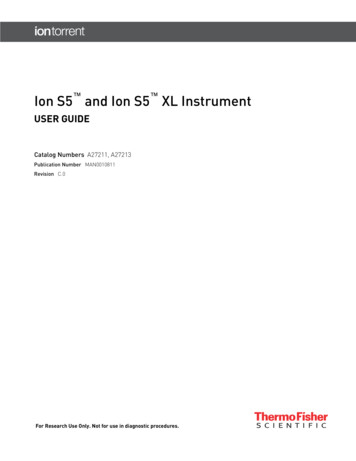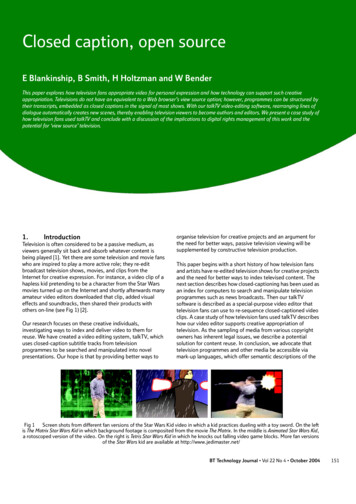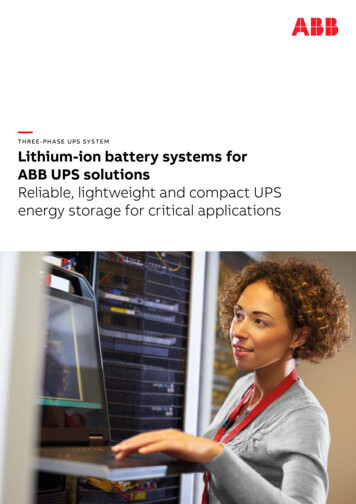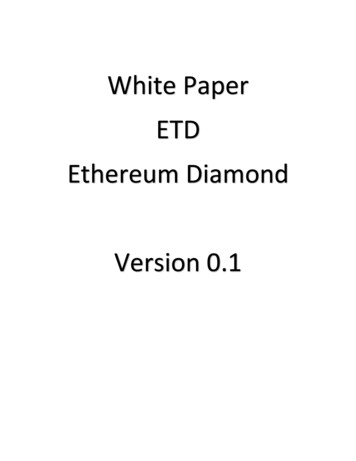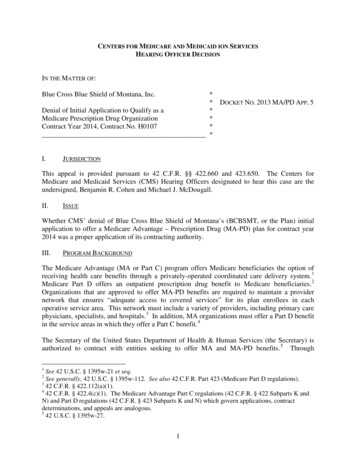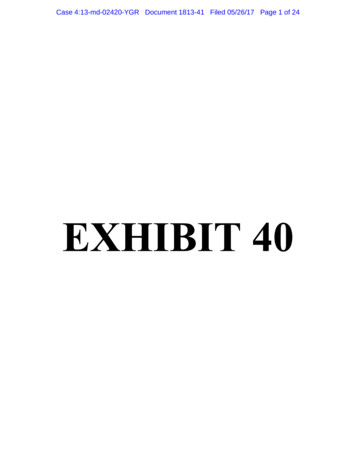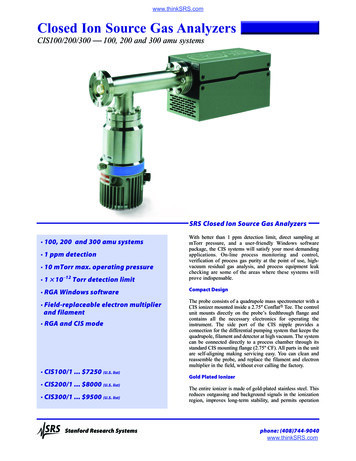
Transcription
www.thinkSRS.comClosed Ion Source Gas AnalyzersCIS100/200/300 100, 200 and 300 amu systemsSRS Closed Ion Source Gas Analyzers· 100, 200 and 300 amu systems· 1 ppm detection· 10 mTorr max. operating pressure· 1 10 12 Torr detection limit· RGA Windows software· Field-replaceable electron multiplierand filament· RGA and CIS mode· CIS100/1 . 7250 (U.S. list)· CIS200/1 . 8000 (U.S. list)· CIS300/1 . 9500 (U.S. list)Stanford Research SystemsWith better than 1 ppm detection limit, direct sampling atmTorr pressure, and a user-friendly Windows softwarepackage, the CIS systems will satisfy your most demandingapplications. On-line process monitoring and control,verification of process gas purity at the point of use, highvacuum residual gas analysis, and process equipment leakchecking are some of the areas where these systems willprove indispensable.Compact DesignThe probe consists of a quadrupole mass spectrometer with aCIS ionizer mounted inside a 2.75" Conflat Tee. The controlunit mounts directly on the probe’s feedthrough flange andcontains all the necessary electronics for operating theinstrument. The side port of the CIS nipple provides aconnection for the differential pumping system that keeps thequadrupole, filament and detector at high vacuum. The systemcan be connected directly to a process chamber through itsstandard CIS mounting flange (2.75" CF). All parts in the unitare self-aligning making servicing easy. You can clean andreassemble the probe, and replace the filament and electronmultiplier in the field, without ever calling the factory.Gold Plated IonizerThe entire ionizer is made of gold-plated stainless steel. Thisreduces outgassing and background signals in the ionizationregion, improves long-term stability, and permits operationphone: (408)744-9040www.thinkSRS.com
CIS100/200/300 Closed Ion Source Gas Analyzerswhile exposed to reactive and corrosive gases. A tungstenfilament is used, which resists corrosive and reactive gasesComplete ProgrammabilityA standard RS-232 interface is provided along with acomplete programming reference. All probe parameters canbe controlled and monitored, and data can be acquired for usein custom applications.Windows SoftwareCIS gold plated ionizerlike WF6 and silane, and leads to extended lifetime. Theclosed (gas tight) design of the ionizer prevents commonlyinterfering species from backstreaming into the ionizationvolume. This produces peaks free of spectral overlap.The CIS systems are supported with a real-time Windowssoftware package that runs on PCs. The intuitive, graphicaluser interface allows measurements to be made quickly andeasily. The program is fully interactive, giving the usercomplete control of the graphical display. Screens can be splitfor dual-mode operation, scales can be set to linear or logformat, and data can be scaled manually or automatically.Data is captured and displayed in real time or scheduled foracquisition at a given interval for long-term data logging.Features include user-selectable units (ppm, Torr, mbar, Paand A), programmable audio and visual alarms, andA Choice of DetectorsThe CIS series analyzers come standard with both a Faradaycup detector (10 ppm detection) and a continuous dynodeelectron multiplier (1 ppm detection). The software allowsyou to easily switch between detectors.RGA Windows software Analog modecomprehensive on-line help. The software allows completeCIS head control with easy mass scale tuning, sensitivitycalibration, ionizer setup, and electron multiplier gainadjustment. For further analysis, data files can be saved inContinuous dynode electron multiplierVersatilityThe CIS systems can also be used in a so-called “RGA mode”.In this mode, the unit has a lower minimum detectable partialpressure, but a lower maximum operating pressure as well.The RGA mode is used, for example, in the first stage of asputtering process when the chamber is evacuated to a lowpressure, and the quality of the vacuum is checked for leaksand harmful contaminants. The unit can then be switched to aCIS mode for sampling directly at higher pressure.RGA Windows software P vs. T modeStanford Research Systemsphone: (408)744-9040www.thinkSRS.com
CIS100/200/300 Closed Ion Source Gas AnalyzersASCII format for easy transfer into spreadsheets. Graphicimages can be saved as META files or copied to the clipboardwhich mounts directly to the CIS head along with a diaphragmroughing pump. When this option is ordered, the entireanalyzer is assembled, tested, and calibrated at the factory.Users can provide their own pumping station; however, it isthe user’s responsibility to ensure that the pumping systemdoes not damage or limit the performance of the instrument.Affordable PerformanceThe SRS CIS systems offer state-of-the-art performance for afraction of the cost of competing models. Standard systemsinclude faraday cup detector, electron multiplier detector andWindows software. Options include built-in power module forAC line operation, and a pumping package that includes aturbomolecular pump and diaphragm pump.RGA Windows software Histogram modefor importing into other Windows programs. The softwarealso provides password protection for locking out headparameters so that casual users can’t alter important settings.An optional stand-alone monitor (PPM100) can be used tocontrol the RGA without a host computer.Multi-Head OperationThe software supports multiple head operation when morethan one CIS is needed. Up to eight ECUs can be monitoredfrom the software.CIS rear panel(without AC power module)CIS rear panel(with AC power module)Pumping RequirementsThe CIS instruments require connection to a pumping systemwith an effective pumping speed of at least 40 L/s and a basepressure of less than 10 9 Torr. The connection port is a2.75" CF flange. Option O100TDP provides a turbo pumpTo CIS Ionizer4.10"CIS Cover Tee3.10"2.46"Pumping SystemPort9.10"Electronics Control Unit (ECU)8.75"CIS ProbeCIS dimensional drawingStanford Research Systemsphone: (408)744-9040www.thinkSRS.com
CIS100/200/300 SpecificationsWarm-up timeOperationalMass rangeCIS100/1CIS200/1CIS300/1Mass filter typeDetector typeResolution(per AVS std. 2.3)1 to 100 amu1 to 200 amu1 to 300 amuQuadrupoleFaraday cup and electron multiplierBetter than 0.5 amu @ 10 % peakheight. Adjustable to constantpeak width throughout mass range.Operating temperature 70 C (max.)Bakeout temperature300 C (without ECU)Computer interfaceSoftwarePowerWeightWarrantyPeak height 2 % after 3 minutes.Mass stability 0.1 amu after30 minutes.RS-232C, 28,800 baud with highlevel command setWindows based application24 VDC @ 2.5 amps. Male DB9connector, optional built-in powermodule for AC line operation6 lbs.One year parts and labor on defectsin materials and workmanshipIonizerDesignMaterialFilamentElectron energyIon energyFocus voltageElectron emissioncurrentClosed ion source, cylindrical symmetry, electron impact ionization.Gold plated SS304Tungsten or ThO2/Ir with firmwareprotection (field replaceable)25 to 105 eV, programmable4 or 8 eV, programmable0 to 150 V, programmable0 to 1 mA, programmableGeneralProbe mounting flange 2.75" CFECU dimensions4.1" 3.1" 9.1" (WHD). Easilyseparated from the probe for bakeout.Probe dimensionsSee drawingLED indicatorsPower ON/OFF, filament ON/OFF,Electron multiplier ON/OFF,RS-232 Busy, Error, Overpressure,Burnt FilamentCIS ParameterElectron emission current (mA)Electron energy (eV)Ion energy (eV)Extraction voltage (V)Sensitivity (A/Torr)(for N2 @ 28 amu)Linear range upper limit (Torr)MDPP (Torr)Range0 to 125 to 1054 or 80 to 150Ordering InformationCIS100/1CIS200/1CIS300/1Option 02O100HJCO100EMO100RFTO100RFWO100RICO100TDPCIS mode0.0570 or 354 or 8 50 (typ.)10 6RGA mode0.5704 or 8 50 (typ.)10 52 10 310 810 410 9100 amu CIS w/ electron multiplier200 amu CIS w/ electron multiplier300 amu CIS w/ electron multiplierAC power module200 C heater jacketReplacement electron multiplier2 replacement ThO2/Ir filaments5 replacement tungsten filamentsReplacement ionizer kit(includes filament)Turbo pump/diaphragm pump 7250 8000 9500 250 395 1000 125 100 900 9975Notes1. The CIS tests were performed with a 70 L/s hybrid turbomolecular pump, backed by a diaphragmpump, attached to the side port of the CIS Cover Tee.2. The RGA mode sensitivities reported were calculated for N2 at less than 10 5 Torr.3. The CIS mode sensitivities were calculated for N2 at 1 to 5 10 4 Torr.4. MDPP (minimum detectable partial pressure) is determined by measuring baseline levels forFaraday cup detection in the presence of 28N2 at 10 5 (RGA mode) and 10 3 Torr (CIS mode). Up to3 orders of magnitude improvement in detectability is possible when the electron multiplier is turned on.Stanford Research Systemsphone: (408)744-9040www.thinkSRS.com
CIS100/200/300 Closed Ion Source Gas AnalyzersClosed vs. Open Ion Source Gas AnalyzersSRS RGAs use an Open Ion Source (OIS) configuration forionization of gas molecules. The OIS extends into the processchamber and is "open" to all gaseous molecules in the vacuumenvironment. The pressure in the ionizer, mass filter, and iondetector is the same as the pressure in the vacuum chamber.The maximum operating pressure for an OIS analyzer is10 4 Torr. However, the maximum pressure can be shifted upto about 10 Torr with the help of a pressure reducing gas inletsystem (PPR). OIS analyzers have the sensitivity and dynamicrange required to detect part-per-million (ppm) levelcontaminants. However, interferences from process gases andbackground outgassing from the sensor itself (i.e. the RGA)can make the detection of ppm levels of some commonresidual impurities, such as water, difficult.In applications requiring the measurement of pressuresbetween 10 4 and 10 2 Torr, the problem of background andprocess gas interferences with the mass spectra can besignificantly reduced by replacing the traditional OIS PPRconfiguration with a Closed Ion Source (CIS) gassampling system.backstreaming into the CIS ionizer from the quadrupoleassembly (approx. 10 9 Torr). This background water signalnow corresponds to a 1 ppm water level in the process gas.The water vapor in the process gas can now be measured tobetter than 1 ppm (a two decade improvement).The combination of direct sampling and differential pumpingallows ppm and sub-ppm detection limits for even the mostpervasive residual gases. For other common interferences,such as organic contaminants or reaction by-products of thefilament, the gas-tight design of the source reduces thevisibility of the ionization region to those gases, providing avery clean residual gas spectrum.The ability of the CIS gas analyzer to sample in the mTorrrange, and to provide ppm level detectability across its entiremass range, makes it ideal for semiconductor processingapplications such as PVD, CVD and etching. However, thehigher pressure limit of the CIS is achieved at the cost of anincreased (two decades typical) minimum detectable partialpressure level relative to an OIS PPR.The CIS ionizer consists of a short, gas-tight tube with twosmall openings for the entrance of electrons and the exit ofions. Ions are produced by electron impact at the processpressure (mTorr range), while at the same time, a differentialpumping system keeps the filament and the rest of thequadrupole assembly at pressures below 10 5 Torr (twodecades lower).Because the sampling pressure in the CIS is typically twodecades higher than that of the rest of the sensor's vacuumsystem, the signal-to-background ratio is significantlyincreased relative to the OIS PPR configuration.1)2)3)4)To illustrate the difference between the two ionizationconfigurations, we use (as an example) the measurement ofwater impurity levels in a 10 3 Torr Ar sputtering processusing both an OIS and a CIS gas analyzer.An OIS cannot be exposed directly to 1 mTorr of processpressure. A PPR must be used to step the total pressure downto about 10 5 Torr. The pressure drop brings a 1 ppm level ofwater in the process chamber (corresponding to a 10 9 Torrpartial pressure of the impurity) to a partial pressure of about10 11 Torr well within the detection limit of a typical RGA.However, the residual pressure in the quadrupole is, at best,10 9 Torr with most of that being water. This water backgroundlevel is one hundred times larger than the 10 11 Torrcorresponding to the 1 ppm of water coming from the processchamber. We conclude that water vapor in the process gascannot be reliably measured to better than 100 ppm.In the CIS system, the Ar gas is ionized directly at 10 3 Torrwithout any intermediate pressure reduction. At the sametime, the background water signal is the same or less than inthe OIS configuration, since it is due to water moleculesStanford Research SystemsRepellerAnode gridFilamentFocus plateCross section of the SRS Open Ion Source (OIS)1)2)3)4)5)6)7)8)RepellerFilamentIonization tubeAlumina insulatorEmission slitAlumina insulatorExit plateExit apertureCross section of the SRS Closed Ion Source (CIS)phone: (408)744-9040www.thinkSRS.com
RGA Windows software . SRS RGAs use an Open Ion Source (OIS) configuration for ionization of gas molecules. The OIS extends into the process chamber and is "open" to all gaseous molecules in the vacuum envir
